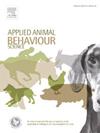白羽和褐羽蛋鸡对不同啄食块的相对偏好进行两两比较
IF 2
2区 农林科学
Q1 AGRICULTURE, DAIRY & ANIMAL SCIENCE
引用次数: 0
摘要
不同的市售啄食块(PBs)有不同的营养成分,外观和质地。然而,蛋鸡对不同PBs的相对偏好是未知的。从18周龄开始,我们将120只Dekalb White和120只Bovans Brown饲养在12个(360 cm x 116 cm x 60 cm)试验笼中。测试笼有两个相同的部分,每个部分包含一个巢,抓痕垫和容器。然后,三种PB类型(A, B, C)在3,4周的时间内进行一系列两两比较(阶段1)。两两比较在三周内重复进行(第二阶段)。A块以矿物+颗粒为主,B块以矿物+颗粒+糖蜜为主,C块以矿物为主。以每周称重法测定铅的使用(消失)情况。在个体水平上,通过对7只焦点鸟(每个笼子)进行活体观察,每周1次(每天3次)来测量啄食和抓挠行为。通过安装在每个PB上的摄像机测量各组的行为。在整个光照期间,使用瞬时扫描采样每5 min计数一次啄食或抓抓积木的鸟类数量(总共= 169次扫描/天,分为3个时间(TOD):上午、中午和下午)。对于阶段1,Browns使用B块比使用其他块和应变组合更多(p <; 0.0001)。在组水平上,两两比较影响啄或抓行为(p <; 0.05)。在白色中(p = 0.04),对B块和C块的成对比较导致更多的鸟啄或抓C块。相反,在棕色中观察到更多的鸟啄或抓B块(p = 0.01)。时间和PB类型之间存在相互作用(白色:p <; 0.0001,棕色:p = <;0.0001)。怀特夫妇在下午的时候啄和挠C区比其他任何地方都要多。在布朗,在中午和上午,啄或抓的对象是B区,比任何其他区域在任何TOD都要多。本研究中常见的2个品系蛋鸡对PB的偏好不同(褐鸡偏好B,白鸡偏好C),在不同TOD下使用。本文章由计算机程序翻译,如有差异,请以英文原文为准。
Relative preference for different pecking blocks offered as pairwise comparisons in White and Brown-feathered laying hens
Different commercially available pecking blocks (PBs) have varying nutrient composition, appearance, and texture. However, the relative preferences of laying hens for different PBs are unknown. We housed 120 Dekalb White and 120 Bovans Brown in twelve (360 cm x 116 cm x 60 cm) test cages from 18 weeks of age. Test cages had two identical sections, each containing a nest, scratch mat, and container. Then, three PB types (A, B, C) were offered in a series of pairwise comparisons over three, 4-week periods (Phase 1). Pairwise comparisons were repeated over three, 2-week periods (Phase 2). Block A mainly comprised mineral + grains, B of mineral + grain + molasses, and C was primarily mineral based. PB use (disappearance) was measured by weekly weighing. Pecking and scratching behaviour was measured at the individual level by live observations of 7 focal birds (per cage) once a week (thrice daily). Behaviour at the group level was measured from video cameras mounted over each PB. The number of birds pecking or scratching at the blocks was counted every 5 min throughout the light period using instantaneous scan sampling (total = 169 scans/day, split into 3 times-of-day (TOD): a.m., mid-day, and p.m.). For phase 1, Browns used the B block more than any other block and strain combination (p < 0.0001). At group level, pair-wise comparison affected pecking or scratching behaviour (p < 0.05). In Whites (p = 0.04), the pair-wise comparison of blocks B and C resulted in more birds pecking or scratching at C. The opposite was observed in Browns, with more birds directing pecks or scratches at B (p = 0.01). Interactions were observed between the time-of-day and PB type (White: p < 0.0001, Brown: p = < 0.0001). The Whites pecked and scratched the C block at p.m. more than any other block at any other TOD. In the Browns, pecking or scratching was directed at the B block at mid-day and a.m. more than any other block at any TOD. The two common strains of laying hens in this study preferred different types of PB (Browns preferred B, Whites preferred C) and used them at different TOD.
求助全文
通过发布文献求助,成功后即可免费获取论文全文。
去求助
来源期刊

Applied Animal Behaviour Science
农林科学-行为科学
CiteScore
4.40
自引率
21.70%
发文量
191
审稿时长
18.1 weeks
期刊介绍:
This journal publishes relevant information on the behaviour of domesticated and utilized animals.
Topics covered include:
-Behaviour of farm, zoo and laboratory animals in relation to animal management and welfare
-Behaviour of companion animals in relation to behavioural problems, for example, in relation to the training of dogs for different purposes, in relation to behavioural problems
-Studies of the behaviour of wild animals when these studies are relevant from an applied perspective, for example in relation to wildlife management, pest management or nature conservation
-Methodological studies within relevant fields
The principal subjects are farm, companion and laboratory animals, including, of course, poultry. The journal also deals with the following animal subjects:
-Those involved in any farming system, e.g. deer, rabbits and fur-bearing animals
-Those in ANY form of confinement, e.g. zoos, safari parks and other forms of display
-Feral animals, and any animal species which impinge on farming operations, e.g. as causes of loss or damage
-Species used for hunting, recreation etc. may also be considered as acceptable subjects in some instances
-Laboratory animals, if the material relates to their behavioural requirements
 求助内容:
求助内容: 应助结果提醒方式:
应助结果提醒方式:


